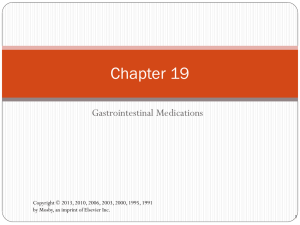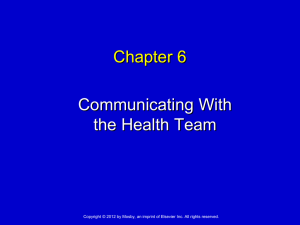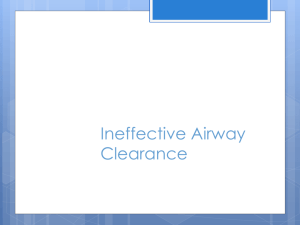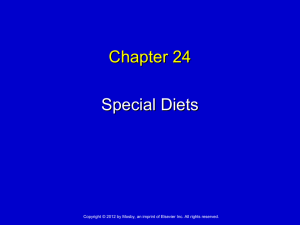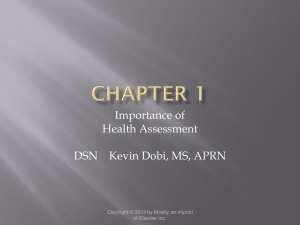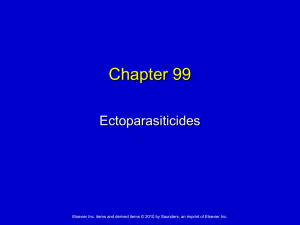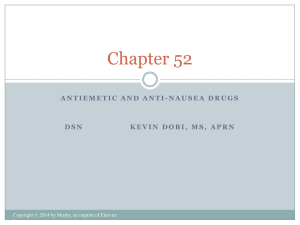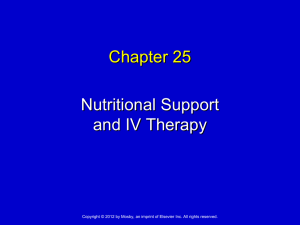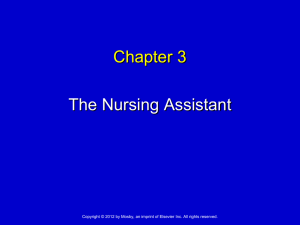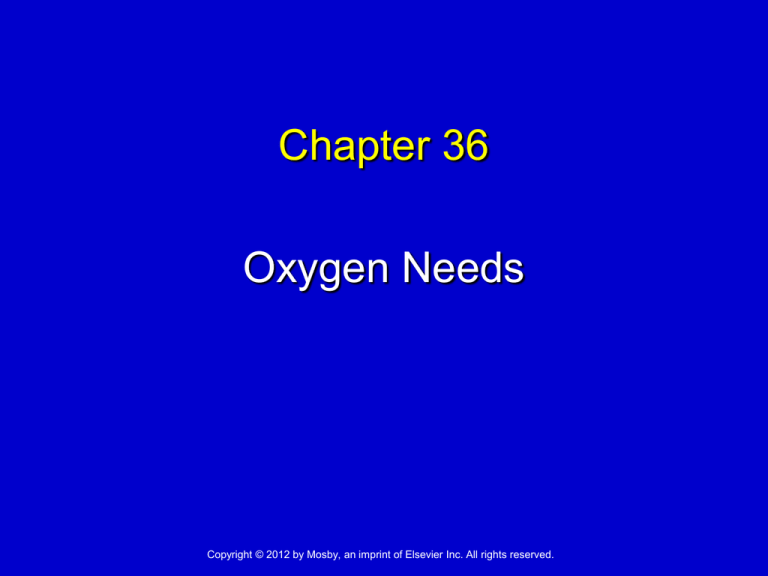
Chapter 36
Oxygen Needs
Copyright © 2012 by Mosby, an imprint of Elsevier Inc. All rights reserved.
Factors Affecting Oxygen Needs (cont’d)
•
•
•
•
•
•
•
•
•
•
Aging—respiratory muscles weaken.
Exercise—O2 needs increase.
Fever—O2 needs and respiratory rate and depth increase.
Pain—respirations increase to meet increased needs for O2.
Drugs—some depress the respiratory center in the brain.
Smoking—causes lung cancer and COPD.
Allergies—severe swelling can close the airway.
Pollutants—damage the lungs.
Nutrition—iron and vitamins are needed to produce RBCs.
Alcohol in excess reduces cough reflex, which increases risk
of aspiration.
Copyright © 2012 by Mosby, an imprint of Elsevier Inc. All rights reserved.
Slide 2
Altered Respiratory Function
Respiratory function involves three
processes.
Air moves into and out of the lungs.
O2 and CO2 are exchanged at the alveoli.
The blood carries O2 to the cells and removes
CO2 from them.
Hypoxia means that cells do not have
enough oxygen.
Early signs of hypoxia are restlessness,
dizziness, and disorientation.
Copyright © 2012 by Mosby, an imprint of Elsevier Inc. All rights reserved.
Slide 3
Altered Respiratory Function (cont’d)
Normal adult respirations are 12 to 20 per
minute.
Infants and children have faster rates.
Normal respirations are quiet, effortless, and
regular.
Both sides of the chest rise and fall equally.
Copyright © 2012 by Mosby, an imprint of Elsevier Inc. All rights reserved.
Slide 4
Altered Respiratory Function (cont’d)
These breathing patterns are abnormal.
Tachypnea—rapid breathing
• Respirations are more than 20 per minute.
Bradypnea—slow breathing
• Respirations are fewer than 12 per minute.
Apnea—lack or absence of breathing
• Occurs in sudden cardiac arrest and respiratory arrest
Hypoventilation—respirations are slow, shallow,
and sometimes irregular.
Hyperventilation—respirations are rapid and
deeper than normal.
Copyright © 2012 by Mosby, an imprint of Elsevier Inc. All rights reserved.
Slide 5
Altered Respiratory Function (cont’d)
Dyspnea —difficult, labored, or painful breathing
Cheyne-Stokes respirations —respirations gradually
increase in rate and depth, and then they become
shallow and slow.
• Breathing may stop for 10 to 20 seconds.
• Cheyne-Stokes respirations are common when death is
near.
Orthopnea —breathing deeply and comfortably only
when sitting
Biot’s respirations —rapid and deep respirations
followed by 10 to 30 seconds of apnea
Kussmaul respirations —very deep and rapid
respirations
• They signal diabetic coma.
Copyright © 2012 by Mosby, an imprint of Elsevier Inc. All rights reserved.
Slide 6
Assisting with Assessment
and Diagnostic Tests (cont’d)
Pulse oximetry measures the oxygen
concentration in arterial blood.
The normal range is 95% to 100%.
A sensor attaches to a finger, toe, earlobe, nose, or
forehead.
A good sensor site is needed.
Oxygen concentration is often measured with vital
signs. Report and record according to agency
policy.
• An agency may use one of these terms.
pulse oximetry or pulse ox
O2 Saturation or O2 Sat
SpO2 (Saturation of peripheral oxygen)
Copyright © 2012 by Mosby, an imprint of Elsevier Inc. All rights reserved.
Slide 7
Baby pulse ox
Copyright © 2012 by Mosby, an imprint of Elsevier Inc. All rights reserved.
Slide 8
Assisting with Assessment
and Diagnostic Tests (cont’d)
Pain, immobility, and narcotics interfere with
deep breathing and coughing.
• Secretions collect in the airway and lungs.
• Secretions provide a place for microbes to grow and
multiply.
Respiratory disorders cause the lungs,
bronchi, and trachea to secrete mucus.
Mucus from the respiratory system is called
sputum when expectorated (expelled) through
the mouth.
Copyright © 2012 by Mosby, an imprint of Elsevier Inc. All rights reserved.
Slide 9
Meeting Oxygen Needs (cont’d)
The following measures are common in care plans.
• Positioning
Breathing is usually easier in the semiFowler’s and Fowler’s positions.
Frequent position changes are needed.
• Deep breathing and coughing
Deep breathing moves air into most parts of
the lungs.
Coughing removes mucus.
Exercises promote oxygenation.
Copyright © 2012 by Mosby, an imprint of Elsevier Inc. All rights reserved.
Slide 10
Meeting Oxygen Needs (cont’d)
Incentive spirometry— also called sustained
maximal inspiration (SMI). SMI means inhaling
as deeply as possible and holding the breath for
at least 3 seconds.
• The goal is to improve lung function.
Atelectasis is prevented or treated.
• This exercise:
Moves air deep into the lungs
Loosens secretions
Promotes the exchange of O2 and CO2
between the alveoli and capillaries
Copyright © 2012 by Mosby, an imprint of Elsevier Inc. All rights reserved.
Slide 11
Incentive Spirometer
Copyright © 2012 by Mosby, an imprint of Elsevier Inc. All rights reserved.
Slide 12
Assisting with Oxygen Therapy
Oxygen is treated as a drug.
The doctor orders:
Some people need oxygen constantly.
When to give O2
The amount of O2 to give
The device to use
If not humidified, oxygen dries the airway’s mucous
membranes.
Bubbling in the humidifier means that water vapor is
being produced.
Oxygen flow rates
The flow rate is the amount of oxygen given.
• It is measured in liters per minute (L/min).
The doctor orders 2 to 15 liters of O2 per minute.
Copyright © 2012 by Mosby, an imprint of Elsevier Inc. All rights reserved.
Slide 13
Assisting with Oxygen Therapy (cont’d)
Oxygen sources
Wall outlet
• O2 is piped into each person’s unit.
Oxygen tank
• The oxygen tank is placed at the bedside.
Oxygen concentrator
• The machine removes oxygen from the air.
Liquid oxygen system
• A portable unit is filled from a stationary unit.
• The portable unit can be worn over the shoulder.
Copyright © 2012 by Mosby, an imprint of Elsevier Inc. All rights reserved.
Slide 14
Types of Oxygen Delivery
Methods
Copyright © 2012 by Mosby, an imprint of Elsevier Inc. All rights reserved.
Slide 15
Assisting with Oxygen Therapy (cont’d)
Oxygen devices
The doctor orders the device for giving O2.
These devices are common:
• Nasal cannula
• Simple face mask
• Partial-rebreather mask
• Non-rebreather mask
• Venturi mask
Moisture can build up under the mask.
• Keep the face clean and dry.
Oxygen is given by cannula during meals.
• The nurse changes the oxygen mask to a cannula.
Copyright © 2012 by Mosby, an imprint of Elsevier Inc. All rights reserved.
Slide 16
Overview of Mask Devices
Copyright © 2012 by Mosby, an imprint of Elsevier Inc. All rights reserved.
Slide 17

